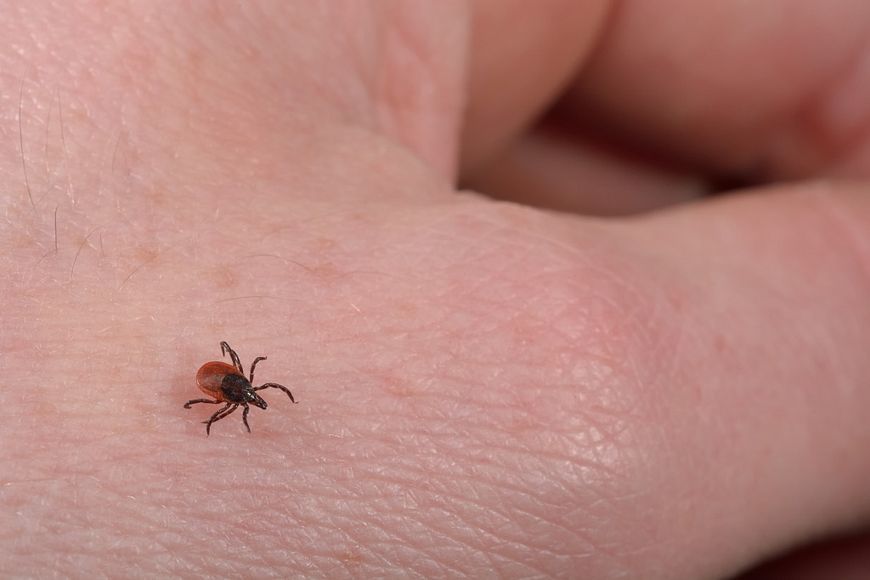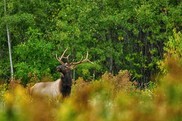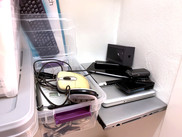Fight The Bite
Lyme Disease Awareness Month: Protect Yourself From Tick Bites

Lyme disease is a bacterial infection spread by deer ticks, which can be as small as a poppy seed. / Photo Credit: Wisconsin Department of Health Services
Tick season is here. Along with the Wisconsin Department of Health Services (DHS), we’d like to remind you to Fight the Bite by protecting yourself from tick bites that may lead to Lyme disease or other illnesses spread by ticks.
Lyme disease is a bacterial infection spread by deer ticks, which can be as small as a poppy seed. Deer ticks are common in Wisconsin and live in wooded areas and brushy or grassy areas adjacent to woods. Because of their small size, deer tick bites can often go unnoticed. Now that warmer temperatures have arrived, ticks are out once again.
You can limit your chance of contracting Lyme disease and other illnesses spread by ticks by following these tips to avoid tick bites:
- Cover as much of your body as possible; ideally, wear long sleeves and pants, and tuck shirts into pants and pants into socks.
- Walk in the center of trails where grass and vegetation are mowed.
- Wear light-colored clothing so ticks are easier to spot and remove quickly.
- Use an EPA-registered insect repellent when you head outdoors. You can also treat your clothes in advance with permethrin.
- Throw your clothes in the dryer for 10 minutes on high heat when you arrive home after recreating.
- Always check yourself, children and pets for ticks, especially behind the knees, under armpits, around the hairline and ears and at the waist.
If you do find a tick embedded in your body, remain calm and remove it as soon as you find it. To remove the tick, use tweezers and grasp the tick as close to the skin as possible while gently pulling it up and out in one fluid motion. Make a note of the date you removed the tick, as this information may be helpful for your doctor to know. Save the tick in a sealed plastic bag or take a photo of the tick before disposing of it in case you develop symptoms later. The easiest way to dispose of a tick is by putting it in alcohol or flushing it down the toilet.
Lyme disease symptoms typically develop between three to 30 days after being bitten by a tick. The often flu-like symptoms include fever, chills, fatigue, muscle aches, joint pain and nausea. Some people who contract Lyme disease also develop an expanding rash, often in the shape of a bullseye. If you think you or a loved one may have Lyme disease, contact your health care provider right away. Lyme disease can be treated with antibiotics.
To help Fight the Bite this summer and learn more about Lyme disease, visit the DHS Fight the Bite webpage. Share how you’re staying safe by using the hashtag #FightTheBite on social media.

Win A Once-In-A-Lifetime Hunt And Help Conserve Wisconsin Elk
The application period for the 2022 elk hunt is open through May 31.
Following several successfully managed Wisconsin elk hunts, the fifth elk hunt in state history is planned for this fall. Wisconsin’s northern elk herd population, centered around Clam Lake, rose to 330 animals in 2021. We anticipate growth in the herd again this year.
Once widespread across North America, elk were eliminated from Wisconsin in the 1880s. Thanks to the support of many partners and the backing of Wisconsinites, the herd is back.
Elk hunting season is open from Oct. 15-Nov. 13 and Dec. 8-16, 2022. Successful applicants can hunt during either period. Only Wisconsin residents are eligible to receive an elk tag.
Wisconsinites can purchase their elk license applications online through Go Wild or in-person by visiting a license agent. The application fee is $10 each and are limited to one per person. The hunt is open to Wisconsin residents only.
The cost of an elk hunting license for the winners of the license drawing is $49. Winners will be notified by early June. Wisconsin residents can only draw an elk tag once in their lifetime.
Before obtaining an elk hunting license, all winners must participate in a Wisconsin elk hunter orientation. The class covers Wisconsin elk history, hunting regulations, elk biology and behavior and scouting and hunting techniques.
The 2022 hunting season is expected to occur only within the northern elk management zone. While the state’s central elk herd has grown steadily since reintroduction in 2015, it is not expected to be included in the 2022 hunt.
For each application, $7 goes directly to elk management and research in Wisconsin. These funds are used to enhance elk habitat, which benefits the elk herd and many other wildlife species that call the Northwoods home. Funding also contributes to ongoing elk research and monitoring.
For more information on the elk hunt, visit the DNR’s elk webpage.
Photo Credit: Jim Kuchler |
Host A Free Fishing Weekend Event
Free Fishing Weekend is less than a month away!
Are you planning to host a free fishing event? Tell us about it and we’ll add it to our webpage to help you promote it.
You can even request materials from us like fishing regulations, fish wildcards and posters.
Don’t let this opportunity slip away – register your event here by May 25.

Recycle Your Old, Unused Electronics
How many unused cellphones, tablets or computers do you have in your home?
Based on a 2021 survey, we estimated there were 2.2 million unused computers and tablets, and 4.1 million unused cellphones in Wisconsin homes.
It’s time for spring cleaning, so recycle your old computers, phones and all the cords, chargers, keyboards and other things that come with them for free at collection sites or events around the state.
Find collection sites near you plus info on events and mail-back programs.
|

|
